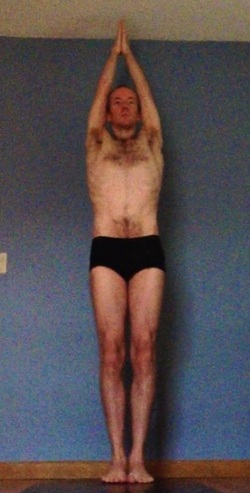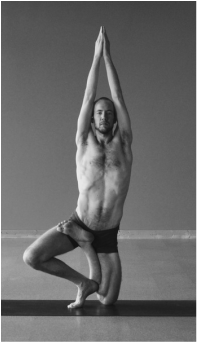|
Sometimes it feels like I am seeking perfection, but then I stop and ask myself "is perfection possible?" or "is it even desirable?" or "why?"
I realize that it is not perfection I am seeking but improvement. There is always room to improve. I can improve my mental focus, I can improve my kindness and generosity, I can improve my diet, I can improve my postures. I probably won't make progress on all of these every day, but my goal is to improve in small increments. Over time the progress will be evident and it will be balanced. It is not enough to improve my kindness while letting my diet or physical health go to crap. And it is not enough to improve my physical strength while letting my mental focus or generosity fade. These things are all important, and I must stay focused on maintaining and growing in all of them.
0 Comments
How do we find our path?
I, like many others, came to yoga through the Posture/Asana practice. I wanted to "get in shape." I wanted to be strong and flexible and be able to stand on my hands. I wanted to be graceful and beautiful. Over the course of about 2 years of daily practice, the Practice did its work on me: the mindful breath, the quiet mind, the linking of mind and body. I found my mind a quieter place and my life more peaceful. I was happier. It was only when I discovered this deeper layer to yoga that I found the beginnings of my path. So if you are new to yoga or struggling to find meaning, I say simply: persist and practice. Practice mindfully, stay present, give honest effort. Practice often, every day if possible. If you persist, the path will reveal itself and you will find that you were walking along it the whole time. Having beautiful postures or a beautiful body is not the point of yoga practice. Quite the contrary really. Exploring and challenging our conceptions of the body is fundamental to the Posture practice. We are only as strong and flexible as we think, no more and no less. Who do you look to for information and advice to advance your yoga practice?
Do you have a favorite teacher or advisor? Do you like to go to classes taught by many different teachers? Do you have questions that don't get answered in a normal yoga class? Where do you look for the answers? Do you read books or search online? Do you observe the practices and advice of more advanced yogis than yourself? Are you ever your own teacher? It is becoming clearer to me that each person's yogic journey is unique. I must be true to my curiosity and motivation just as you must be true to yours. As the ancient texts say: many paths that lead to the same goal - unity, oneness. Peace and happiness. Love and compassion. Yoga teachers are nice, especially at the beginning of the journey, but we must make sure that we are nurturing our own identities, strengths and curiosities. When we know who we are and what we want, a teacher's guidance grows tenfold in meaning. To me yoga is about one thing: happiness.
We walk the path toward happiness Through health, strength, resilience, humility, compassion and inner peace. The path of yoga is different for everyone. It is the goal of the yogi to find his/her own path And then to walk it. It is the goal of the teacher to aid the yogi in finding that path. Most every day my teacher Tony Sanchez posts something about yoga to his Facebook page. Every now and again he writes something that really resonates with me. Yesterday was one of those days. His post is below. I love the encouragement that self-confidence, like everything else, can be practiced and developed. I also love the reminders to stay humble and true: "Practice for understanding and not for power over others." His complete post is below.
"GUIDED YOGA PRACTICE Empower your practice with faith in yourself and in yoga. Don't expect progress when doubting yourself. Personal doubts are apt to backfire and set you back. Indifference and lethargy grows out of lack of confidence. Work on self-confidence for best results. In the beginning of yoga practice bad days are common. Persist and good days will shine forth. Practice for understanding and not for power over others. Be effective, not vain."  While practicing this morning, I noticed something interesting and powerful while standing with my feet together and arms extended overhead (pictured). When I found my center of gravity - the point of balance where my weight is shifted neither forward, backward or to the side - my body automatically engaged in so many of the ways they harp on in yoga class. My weight is in my heels with only slight balancing weight in the big toes and small toes. My quadriceps engage, though only slightly. They are certainly not limp, but they are also not tight and locked with great effort. The slight engagement of my quads lifts my kneecaps. My pelvic floor (mula bandha) and lower belly (some call it uddiyana bandha) engaged, though again not intensely; about 50% of a mind-driven muscle engagement. My point of focus was my spine and keeping its natural curvature. When my spine is relaxed and strong and my weight is centered in opposition to gravity, the body seems to spring upward and open. It floats without effort but remains absolutely present. This makes me re-think the way that we teach muscle engagement in yoga class. For years I have heard: "Lock the knee, lift the kneecaps, engage Mula Bandha!" as if they are independent mental engagements like puzzle pieces that make a proper posture. But more and more it seems that these are results of a proper posture instead of the building blocks. If someone wants to be a race car driver, they don't begin by driving at 150mph even though that is the most obvious characteristic of a race car driver. They begin by learning to drive with perfect awareness and the speed will come. The same seems true of yoga postures and specifically these physical engagements. The engaged quadricep, lifted kneecap and Mula Bandha are results of proper balance in the body. Perhaps we should be teaching balance and body awareness in space instead of which muscles to engage. After all, our muscles are designed to serve the body, not the body to serve the muscles. ps. This posture (standing or sitting with arms extended overhead) reminds me also of ancient yogic postures designed to awaken the body's energy. It could be that this is a fundamental and powerful position for the body. We all know that we should drink plenty of water to stay hydrated. Did you know that water molecules - H2O - are necessary to break down our food and nutrition? Without sufficient H2O we can't break the food we eat into smaller sugars that our body uses for energy. Even if we eat the best and healthiest foods but not enough H2O, we can't digest them effectively.
So be sure to drink plenty of water. Your body needs it to function and especially to get the most out of the food you eat. For years TKV Desikachar taught yoga to the great philosopher Krishnamurti. Krishnamurti was a humble and respectful student. Through all the years they spent together, he only offered three short pieces of advice to Desikachar: "Sir, don't become a guru, don't exploit, don't become rich."
From Health, Healing and Beyond by TKV Desikachar If our teachers are inspiring, it is because they are authentic; they teach from their own personal experience. A good teacher passes on what is absolutely true and pure to them, not a dogma or a tradition but real and immediate and personal.
If we are to be authentic we can't possibly teach what our teachers taught us. We must teach the yoga as is true to ourselves. We can try to copy our teachers by imitating their expressions, sequences and even word for word, but that yoga becomes stale quickly. We become puppets or copies or foot-soldiers. We must take our own inspiration and hold it dearly. We must nurture it and help it grow. We must explore our own yoga - what feels good, what feels right, what pushes us deeper, where are our blocks, how do we get past them? Then we must teach that. It will not be the yoga of our teachers, it will be our own. We must always practice yoga, always explore, always move deeper. Then we can teach from true and immediate experience and inspiration. |
This journal honors my ongoing experience with the practice, study and teaching of yoga.
My FavoritesPopular Posts1) Sridaiva Yoga: Good Intention But Imbalanced
2) Understanding Chair Posture 2) Why I Don't Use Sanskrit or Say Namaste 3) The Meaningless Drudgery of Physical Yoga 5) Beyond Bikram: Why This Is a Great Time For Ghosh Yoga Categories
All
Archives
November 2017
|


 RSS Feed
RSS Feed